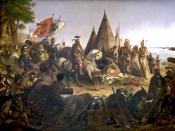The short works ÃÂReading the RiverÃÂ by Mark Twain, and ÃÂThe Way to Rainy MountainÃÂ by N. Scott Momaday, are personal tales of moments in the authorsÃÂ lives and how those experiences impacted them spiritually. The central theme of both essays is that of impressing upon the reader to be careful not to take everyday life for granted. Both authors accomplish this mission by relying on examples from nature, but Momaday goes a step farther and incorporates his Native American heritage into the explanation of his world. Twain writes about learning to guide a riverboat down the Mississippi River and to look for tell-tale signs of positive or negative aspects that may affect the journey. He describes how, after so many years of looking for things in or on the river, he has lost the ability to appreciate the beauty of the river itself that others take for granted.
Nature is also an important element in the writings of Momaday. He uses lush language to describe the mountains and the plains in order to relay his deep respect of his surroundings. He also describes the oral history of his tribe, the Kiowas, which his grandmother handed down to subsequent generations. When his grandmother died, he realized that she was the last Kiowa who had ties to the history of the tribe and that any tales told from then on would be merely reiterations of her stories, rather than the actual story-telling itself.
Both authors compare the subject of their interest to that of a story, be it a book or a tale well told. In this way they are able to fascinate the reader rather than merely preach their advice. It could even be argued that both authors are merely engaged in the fanciful retelling of their...


